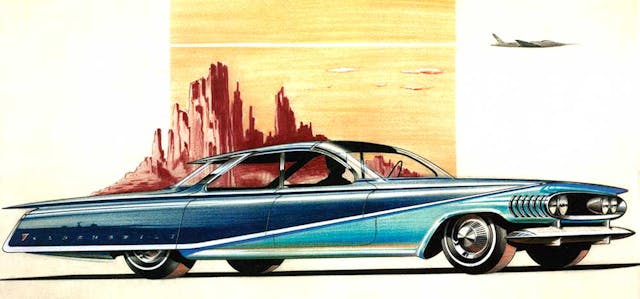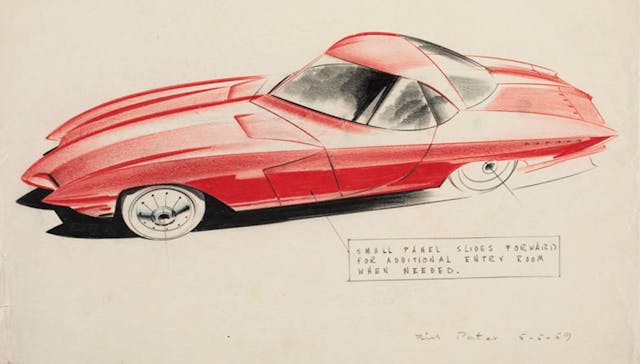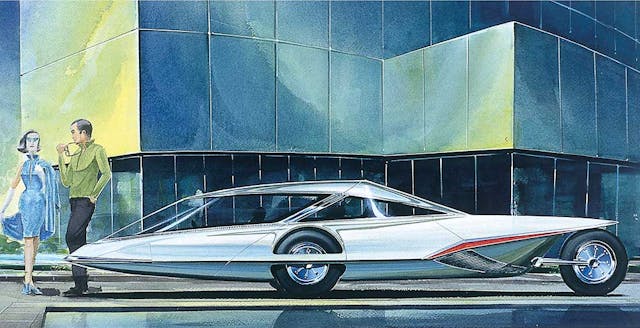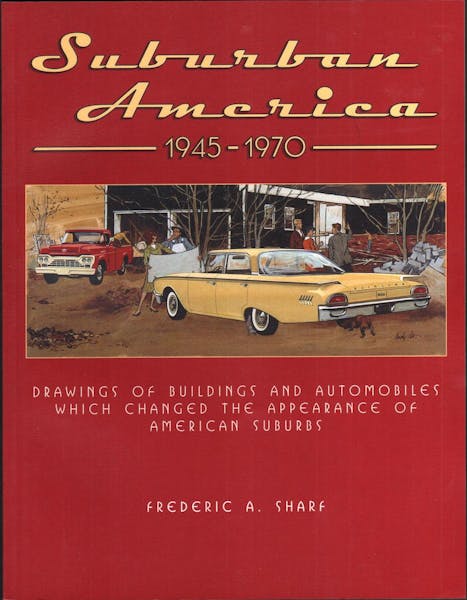Media | Articles
Ever admired vintage automotive sketches in a museum? Thank Fred Sharf

Thanks to a pandemic-related extension, you have months rather than weeks to experience the Detroit Style: Car Design in the Motor City, 1950–2020 exhibit on display at the Detroit Institute of Arts until January 9, 2022. (It was originally scheduled to depart at the end of this month.) While his name isn’t mentioned in the hardcover book published to accompany the exhibit, nor are any of the works in it from his personal collection of original automotive studio drawings, there’s a very good chance that the Detroit Style exhibit, and similar shows at art museums around the world, would never have happened if it were not for the late Frederic A. Sharf (1934–2017).
Detroit Style incorporates 12 significant automobiles along with dozens of sketches, drawings, and full-scale paintings used in designing automobiles. It was Sharf who did the most to convince the fine art world that the work of automotive designers was worthy of museum display.

It wasn’t just the art world that Sharf influenced. His collecting, curating, and publishing helped convince the automotive industry that its drafts, sketches, and renderings were indeed art and deserved to be archived, not discarded. The very existence of the Detroit Style show at the DIA—in part sponsored by General Motors, Ford Motor Company, and Stellantis (Chrysler’s current corporate parent)—shows that.

There was a time when very few of the drawings or paintings produced in automotive styling studios left the studio. The artwork would be discarded to make room for the next project, just as the clay used to render those studies in 3D would be recycled for the next product cycle. What wasn’t thrown away was considered proprietary information and kept far away from public eyes. Of course, nothing is 100 percent secure and artists, proud of their work, often snuck their prized sketches home for safekeeping.

Described by a close friend as a “true renaissance man,” Frederic Alan Sharf’s passion for history and its artifacts began in his childhood. His family was affluent thanks to M. Sharf and Co, a successful wholesale distributor of sporting goods started by Fred’s grandfather in 1892. Fred purchased his first painting, an antique landscape, for $11 before he reached his teens. He attended the Phillips Academy prep school before going to Harvard, where he earned a master’s degree in history. Rather than continue as an academic, he decided to work for the family business. Under Fred Sharf’s leadership, the company transitioned to become the Sharf Marketing Group, representing professional hockey and tennis players. By the early 1980s, Fred estimated that his firm was the agent for about 25 percent of the world’s top women tennis players.
Marketplace
Buy and sell classics with confidence

Representing those players meant a lot of world travel, giving Fred and his wife Jean the chance to study a wide variety of art and amass an eclectic collection. Fred applied an academic approach to their collecting: “My passion is research,” he told The Boston Globe in 2009. “I love to buy things, and then I like to research what it is I bought. Very often that puts me in a position where I know more than anybody else knows about some of this stuff.”

Fred didn’t simply accumulate things for his own purposes; he shared both the artifacts he collected and the history behind them. He authored or cowrote more than 40 books and exhibition catalogs along with dozens of articles in art magazines and academic history journals. The Sharfs donated more than 2700 works to Boston’s Museum of Fine Arts, where Fred was a trustee, as well as millions of dollars to Boston-area charities devoted to art and health care. The Sharf name graces both museums and hospitals.
“He makes a collection and then gives it away. He’s very project-oriented. He’s come home at night after being out and starts typing away,” Jean Sharf told The Boston Globe.

Fred’s initial focus was on Japanese art—woodblock prints in particular—but the Sharfs’ collections expanded to include historic manuscript diaries and letters, vintage photography, American architectural design drawings, toys, designer dresses, and American folk art. It was his interest in architectural renderings that drew him to collect automotive design art.
Moving from Japanese woodblocks to British imperial documents, Fred started to collect the presentation drawings architects would use to pitch clients.

“The architects would draw cars beside the buildings,” Fred told Automobile magazine in 2011. “I started to wonder about those cars.” If the buildings needed drafts, then so did cars. “I became curious about the car drawings,” he said. “They also turned out to be evocative of their eras.”

With the help of enthusiast Hampton Wayt, whom Fred credited with originating serious interest in styling art, Fred started to track down retired designers that had worked for the Detroit automakers. In many cases it was the original designers’ heirs who preserved the work, and they were thrilled that Fred was taking an interest. While company security meant the vast majority of styling drawings could never be made public, there were exceptions. Famed Pontiac designer Bill Porter saved enough work to host organized art shows, and GM stylist Carl Renner told Fred that design chief Harley Earl gave him permission to take drawings home.

Speaking of Renner, one of Fred’s books is devoted to his work, particularly his Motorama and dream cars. Bringing attention to the artists seemed to have been as important to Fred as shining light on their art. Another of his books is about Harry Bentley Bradley, best known for designing the first series of Hot Wheels cars for Mattel. Fred’s book, Future Retro, published by the MFA, includes an essay on automotive styling by Richard Arbib, another GM designer about whom Fred wrote.

Fred’s collection of original automotive styling art grew to include thousands of drawings and paintings. He then started to introduce them to the fine art world by way of his philanthrophy. Having once been treated for an injury at Boston’s Brigham and Women’s Hospital, he and Jean funded the construction of a new patient admissions area; once the facility was finished, they lent some of their drawings to display in the hospital. That show drew visitors, including Koji Yamada, a curator at Toyota’s corporate museum, who asked Fred if he could loan him some pieces. A selection of about 150 works was sent to Japan, where the show was so well received that it went on tour at museums across North America.
When Boston’s MFA decided to exhibit some vehicles from fashion designer Ralph Lauren’s extensive car collection, the display included works from the Sharf collection. The Sharfs donated many drawings to the MFA and also established a curator’s position devoted specifically to automotive design art. Other shows in which Fred has participated focused on Harry Bentley Bradley, as well as the Fisher Body Craftsman’s Guild, a talent and scholarship competition General Motors used to identify potential members of its design team.

Fred kept a library at the Larz Anderson Auto Museum in Brookline, Massachusetts, which has a small gallery devoted to pieces from his collection.

For all of his interest in automotive art, though, Fred Sharf wasn’t much of a car guy. He drove a ten-year old Mercedes that he said embarrassed the family’s housekeeper. “I’m interested in the people,” he said in the Automobile interview, “and the stories.”

If you’d like to start collecting automotive styling art, a relatively inexpensive way to begin might be purchasing one or more of Frederic Sharf’s books, typically published to accompany exhibits from his collection. They have high-quality reproductions of the works in his collection, and while they are out-of-print, you can generally find them via online booksellers.
Frederic A. Sharf automotive styling bibliography
Arbib, Richard, and Frederic Sharf. Future Retro: Drawings from the Great Age of American Automobiles Hardcover. Boston: MFA Publications, 2006.
Berger, Michelle, and Frederic A. Sharf. American Automobile Art, 1945–1970. Newburyport Press, 2007.
Sharf, Frederic. Carl Renner: 1950s GM Dream Machine Car Creator. Frederic A. Sharf, 2011.
———. Harry Bentley Bradley: American Automotive Design Innovator. Frederic A. Sharf, 2008.
———. Richard H. Arbib 1917–1995: Visionary American Designer. Newburyport Press, 2006.
———. Suburban American 1945–1970: Drawings of Buildings and Automobiles Which Changed the Appearance of American Suburbs. Brigham and Woman’s Hospital, 2002.













